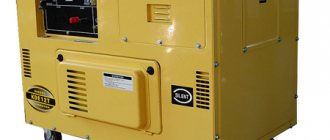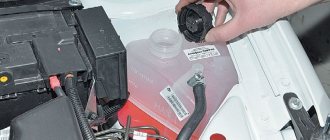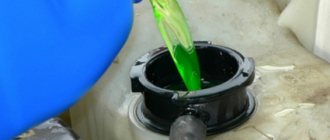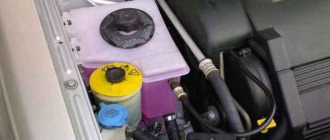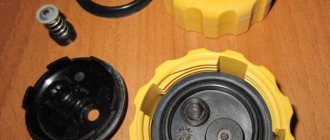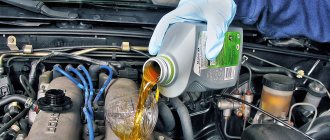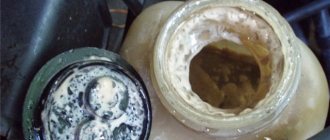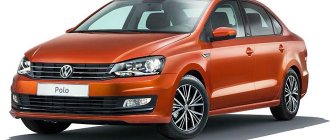All drivers, without exception, are familiar with the word “antifreeze”. However, not everyone, in particular novice drivers, knows exactly what function it performs in the car. Today we will look in detail at what antifreeze is, its properties, what types it comes in, and also how to choose it correctly.
View the full catalog of "Antifreeze"
What is antifreeze?
“Antifreeze” can be translated from English as “not freezing” (anti – against, freeze – freeze). This word is used all over the world to refer to a special liquid that is poured into the cooling system of a car’s power unit.
Antifreeze (coolant) circulates smoothly between the system and the radiator, removing excess heat, preventing overheating and engine failure.
Due to its specific composition, the freezing point of antifreeze is significantly lower than that of water, so there is no fear that the liquid will freeze in severe frosts and the system will suffer (even to the point of rupturing the engine walls). Accordingly, this product is effective and safe for the cooling system and the engine as a whole.
Coolant for heating - basic information and characteristics
First, let's define what a coolant is. The coolant for a heating system is a liquid substance used to transfer thermal energy from a heat source to heating devices. Sometimes steam is used to transfer heat, but not in domestic heating systems.
Based on the definition, you can understand what qualities the coolant should have:
- transfer the maximum amount of heat from the heating boiler to the radiators;
- ensure the lowest possible heat loss during this transfer;
- have low viscosity - otherwise the speed and temperature of the coolant in the system will drop, and losses will accordingly increase;
- do not cause corrosion of pipes and radiators through which it passes;
- do not leak or leak;
- be safe to use.
The cost of the coolant is also important, especially in our time. But let’s make a reservation right away - the stingy pays twice, and it’s better not to save on coolant.
Let's also figure out the difference between coolant and antifreeze. Antifreeze is a general name for liquids that do not freeze at low temperatures. Let us remember that among the requirements for the coolant is safety in operation. One of the main sources of danger in our latitudes is freezing of the coolant due to a gas or electricity cut-off and, as a result, a complete failure of the entire heating system of the house. To prevent this, it is recommended to use antifreeze as a coolant. Although some believe that the best coolant is water.
Coolant composition
All antifreezes have the same composition:
- 90%
– ethylene glycol (propylene glycol) base; - 5-7%
– a complex of additives (anti-corrosion, anti-foam, stabilizing); - 3-5%
– water; - dye
(mostly red, green or blue).
NOTE!
Ethylene glycol is an oily, sweetish liquid that is a potent poison. The lethal dose for an adult is 200-250 ml. Ethyl alcohol will help neutralize the effect of the poison.
Useful properties of antifreeze
The main performance properties of coolants include:
- maintaining performance characteristics over a wide temperature range;
- high boiling point (from 108 to 160°C);
- low freezing temperature (from -25 to -65 °C);
- high thermal conductivity;
- stabilization of system operation;
- reliable protection of metal parts of the radiator and internal combustion engine from corrosion;
- effective protection of all elements of the cooling system from cavitation;
- preventing foaming at elevated temperatures;
- neutrality (does not corrode) in relation to rubber and polymer parts of the cooling system (hoses, seals), as well as their protection from drying out and cracking.
Antifreeze color
Many people mistakenly think that its performance properties depend on the color of the coolant. It really doesn't matter whether the antifreeze is red or green.
Initially, the goal that manufacturers pursued when painting the coolant was to hint to drivers that the cooling system was leaking. Seeing bright stains under his car, the owner immediately realized that a leak had occurred and urgent repairs were required.
Today, bottles with bright colored liquid can be regarded as a marketing ploy that attracts the attention of potential buyers. Manufacturers can paint antifreeze in any color they like, so you cannot select coolant by color!
NOTE!
It is strictly forbidden to mix antifreeze based on their color!
The principle of “red with red” or “green with green” does not work here at all, since liquids of the same color can have completely different composition and performance characteristics. That is why you can add coolant of any color, the main thing is that it has a similar composition to the liquid originally poured into the system.
What should you do if a situation arises in which you need to add coolant (more than 200 ml), but you don’t know what composition is already in the system? In this case, experts advise completely replacing the antifreeze in accordance with the manufacturer’s recommendations.
If you need to add a little liquid, up to 200 ml, use distilled or filtered water (never tap water). This will not disrupt the working properties of the composition (in fact, you will simply restore the amount of water that evaporated under excess pressure).
Shelf life
The period of use before and after opening the container will be completely different. Unfortunately, manufacturers do not indicate this feature on the packaging.
If the container is sealed and has not been opened, it can be stored for more than five years.
The liquid will not undergo any changes in properties during storage. No sediment will fall to the bottom of the container.
After opening the container, you can use a device such as an aerometer. It measures the ratio of antifreeze base to distillate.
After the container is opened, the liquid begins to come into contact with oxygen, the composition changes, oxidation reactions occur, and the shelf life is significantly reduced.
Antifreeze classification
The classification developed by Volkswagen specialists has become generally accepted throughout the world. According to its standards, all coolants are divided into three groups - G11, G12 and G13.
G11. It is produced using the traditional (silicate) method using a small amount of anti-corrosion, lubricating and anti-foam additives from inorganic substances (silicates, phosphates, nitrites, etc.). Today, G11 coolants are considered obsolete. Manufacturers do not use them when first filling a car because the service life of inorganic inhibitors is a maximum of 2 years. In addition, they cannot withstand temperatures above 108 °C.
G12. It is distinguished from G11 by the absence of silicates in the composition - organic carboxylic acids are used instead. Thanks to this, the anti-corrosion, anti-cavitation and other useful properties of G12 are significantly higher. Also, the advantage of antifreeze of this class is a longer operating period - about 5 years without replacement.
*Antifreezes marked G12+, G12++ are improved varieties of G12, characterized by more effective additives, a minimum of harmful impurities, even greater purity of the base and an extended service life, up to 8 years.
G13. A new class of antifreeze developed using propylene glycol. Unlike coolants made from toxic ethylene glycol, they have an environmental (non-toxic) basis that meets European environmental safety requirements. Among all types of coolants, G13 is the most expensive in price, while in fact it differs from G12+ and G12++ only in its environmental friendliness.
ON A NOTE!
Antifreezes of the same type are allowed to be mixed. For example, G11+ and G11 or G12+ and G12. At the same time, it is impossible to fill G11 and G12 coolant at the same time due to the incompatibility of the additives in the composition.
When and how to use?
Attention is given to specification and applicability to a specific make and model. The service life of the equipment depends on this.
Draining is carried out using specialized suction devices that remove dirt from inside the pipes.
note
The concentrate cannot be poured in; it must first be diluted with distilled water. The proportions depend on the manufacturer's recommendations, as described on the packaging. It is not recommended to use antifreeze of different specifications that have a different composition.
5 minutes to read.
Despite the fact that the auto chemical market is increasingly filled with carboxylate and lobride antifreezes of the new generation, silicate ones are also not losing ground. This is understandable: they are time-tested and tested by many car enthusiasts, and are also sold at a lower price. - a leader among Russian manufacturers of auto chemicals - has improved silicate antifreezes, significantly improving their properties and increasing their service life. Thanks to this, they can compete with the latest developments. One of these is Sintec Antifreeze Euro G11.
The difference between ready-made antifreeze and concentrate
Overall, these are the same product. Their most important difference is their saturation, since ready-made antifreeze is a concentrate diluted with water.
It is believed that concentrate is an economically more profitable purchase. In turn, the finished coolant does not require wasting extra time on dilution with water, and is therefore more convenient for use. Therefore, what is better to choose - antifreeze or concentrate, each driver must decide for himself, based on personal preferences.
| GM Antifreeze red | Mobil Concentrate | Total Concentrate | CoolStream Antifreeze |
| More details | More details | More details | More details |
View the full catalog of "Antifreeze"
Technical and operational characteristics
The Sintek cooler is made on the basis of a water-glycol mixture, to which corrosion inhibitors are added using a special organic technology. The product does not contain silicates, nitrates, phosphates, borates and amines. The result is the purest coolant without unnecessary chemical components. This is what explains its high properties and long service life.
Key performance indicators:
- crystallization temperature - minus 40 degrees;
- density - 1.073 g/cm 3 at 20ºС;
- pH value - 8.4 pH;
- alkalinity - 4.6 cm³.
Different brands of Sintek antifreeze differ in color and standards. For example, red coolants comply with the G12 standard. Their price is an order of magnitude higher than that of the G11 standard coolant.
If you own a vehicle, then sooner or later you will be faced with a choice of fluid for the cooling system. This fluid is an integral component for normal engine operation. Therefore, today we will tell you why Sintek antifreeze is so popular among car enthusiasts, and also bring to your attention reviews of other drivers about it.
If antifreeze is made using good equipment, and it is based on high-quality components, then your car will never:
- the engine will not boil;
- the coolant will not foam;
- no sediment forms in the cooling system;
- corrosion will not kill system elements.
[Hide]
Antifreeze standards
Today there is a generally accepted standard in the world, which was originally developed by the Americans. He divides automotive coolants into 2 types:
- ethylene glycol base (ASTM D 3306, D 4340, D 4985)
- Eco-friendly propylene glycol base (SAE J1034).
But, despite this, Russia has its own standard - GOST 28084-89, Great Britain - BS6580:1992, Austria - ONORM V5123, Germany - FWHEFTR 443, Japan - JISK 2234, etc. Each of them is designed in accordance with the climate of its country, while taking into account the climatic characteristics of other consumer countries (cars of other brands, the nuances of their cooling systems).
What to add, what to replace?
The most common question I hear in car dealerships is: “but I have red antifreeze, can you recommend something to top it up?” (Color chosen as an example).
And they do advise!!! I try not to get involved in such “small” conversations.
As a rule, in the first 3 years 100-200 mg is enough. Coolant to top up. There will be nothing wrong if you add distilled water to the tank. But if you add purchased “red” antifreeze “anyhow”, you may have major problems. Counterfeits contain glycerin and methanol. The rate of corrosion of your cooling system will increase significantly. But it will be possible to find out about this only after corrosion products appear in the expansion tank. Those. it may already be too late.
Even if you are lucky and buy a non-counterfeit fluid, where is the guarantee that you will guess the type of additive package? But if you still need to add coolant (some cars have increased coolant consumption because the operating temperature of the engine is too high), then you should only buy it from an official dealer or from an official representative of this brand. You can see exactly what to fill in in the car’s service book, or on the official website, or by calling the automaker’s support service.
If you have a second-hand car with an opaque service history, it’s better not to be too lazy to replace the coolant with flushing completely; repairing the internal combustion engine can cost tens of times more.
When completely replacing the coolant, you will have to choose what to fill, no matter what label will be placed on this product “Tosol” or “antifreeze”; the manufacturer’s approvals are more important, because Different manufacturers use different materials and solders, and laboratory tests are carried out to determine compatibility with them during certification. But, unfortunately, compliance with GOST standards (in addition to GOST 28084–89, GOST 9.030 “Unified system of protection against corrosion and aging. Rubbers. Test methods for resistance in a non-stressed state to the effects of liquid aggressive media” can also be used.” In matters relating to the impact on RTI), international standards and manufacturer approvals do not always guarantee stable quality of commercial products. Therefore, I recommend that once you find a good antifreeze for yourself, stop with it and not experiment further https://www.avto3.com/operation/antifreeze.html - my sad story about trying to replace good with better.
What is the difference between antifreeze and antifreeze?
Most experienced drivers know that both products are coolants, which differ in their technical and operational characteristics. Let's take a closer look at them.
Initially, “antifreeze” was developed for the cooling system of Soviet cars in the 70s of the last century. This was a liquid improved at the GosNIIOKhT Institute, which replaced the ordinary water that had previously been poured into the radiators. For old cars with brass radiators and cast iron motors, this cooling method was safe, but for more modern engines it threatened to damage the cylinder block, pipes or the entire system as a whole. The composition of the new product, called “antifreeze,” in addition to water, included ethylene glycol and additives based on inorganic salts, which protected the internal combustion engine from corrosion.
As for antifreeze, these are the same coolants, but only imported and with a more advanced composition. Antifreeze, unlike its foreign counterpart, forms an anti-corrosion layer 0.5 mm thick over the entire surface of the system.
Because of this, the metal transfers heat less well, and the efficiency of the cooling process is noticeably reduced, accelerating engine wear and increasing fuel consumption. In addition, antifreeze loses its performance characteristics after 35,000-40,000 km. In turn, the imported product “works” more delicately, forming a protective layer not over the entire surface, but only on problem areas of the system. Thanks to this, heat exchange is not disturbed and the service life of the unit is extended. In addition, antifreeze is more resistant to boiling (115°C) than antifreeze (107°C) and its replacement is required after 250,000 km.
ON A NOTE!
It is prohibited to mix antifreeze with antifreeze at the same time due to the difference in composition.
Unlike imported coolant, antifreeze contains aggressive silicate, which negatively affects the channels. The consequences of mixing two products without flushing the cooling system can be corrosion, sediment that will clog the channels, deterioration in the performance properties of the liquid, etc.
Syntek options
As you already understand, Sintek refrigerants can be found in the store in different variations. How do they differ from each other and which one is better? We'll talk about this later.
Sintek refrigerant is offered to consumers in several forms:
- “Universal” (blue);
- "Euro" (green);
- "Ultra" (red color);
- "Gold" (yellow);
- “Antifreeze coolant -40” (blue color);
According to data from the official manufacturer, these silicate refrigerants do not contain nitrates or other substances that form a carcinogen during chemical reactions. That is, the company’s coolants are theoretically compatible with all high-quality refrigerants.
Automobile manufacturers require antifreeze manufacturers to ensure that their products provide the vehicle with a minimum mileage of 30 thousand kilometers. But Sintec antifreezes have a balanced package of additives that can increase the service life of the coolant from 100 to 120 thousand km.
As for the operating temperature range, for all of the above five types of refrigerants it ranges from -40 to 108 degrees Celsius. As you can see, Sintek antifreezes have different colors, but the same service life and operating temperature range. But the manufacturing company also has several other types of refrigerants sold that are worth highlighting separately:
- "Lux" G12 (red-orange color);
- "Premium" G12+ (raspberry color);
- "Unlimited" G12++ (purple);
“Lux” is a carboxylate coolant (coolant), which does not contain silicates, nitrites and amines. These refrigerants have been approved by domestic automakers VAZ, KAMAZ and many others and are capable of protecting the car’s cooling system from corrosion. The service life of this liquid is 250 thousand kilometers. It is also compatible with major types of rubber cooling system components.
“Premium” is an improved carboxylate refrigerant with an increased service life, which differs from other antifreezes in its high heat transfer coefficient. This is achieved as a result of the fact that the coolant does not cover the surface of the system parts with a layer of protection, but only creates a thin film in those places where corrosion may occur. In addition, according to the manufacturer, this refrigerant can provide excellent system protection under extreme climatic conditions.
Also, “Premium” does not contain additives that can create sediment in the system pipes. Antifreeze is recommended for most types of cast iron and aluminum engines, and its service life is about 250 thousand km. In terms of performance, the refrigerant is significantly superior to traditional antifreeze.
“Unlimited” - this refrigerant is lobrid and the only one produced in the post-Soviet space. As in the case of “Premium”, the coolant creates a thin protective film in those places of the cooling system where corrosion can occur. The main difference between this type of refrigerant is its unlimited service life.
Antifreeze SINTEC
is a well-deserved leader in the Russian antifreeze market and one of the largest manufacturers of coolants.
Antifreeze "SINTEC"
are widely known and in demand not only in Russia, but also in the CIS countries, near and far abroad.
Quality of SINTEC
is the result of 15 years of painstaking work by the company’s specialists to
improve recipes and technologies
.
Thanks to the presence of our own research and testing department, the constant introduction of advanced technologies and the latest developments is ensured.
Our own accredited testing laboratory (accreditation certificate No. ROSS RU. 0001. 21 NT 47) carries out strict quality control of products
at every stage of production. The laboratory is equipped with the most modern analytical equipment, including 15 stands for testing the corrosion effect on metals in accordance with GOST 28084 and a double-circuit circulation stand for determining cavitation corrosion of antifreeze in accordance with ASTM D 2570.
The company has a high production culture, which is confirmed by the presence of a number of certificates of conformity:
- quality management systems - the requirements of international standards ISO 9001:2008, as well as the requirements for a quality system in the automotive industry ISO/TS 16949:2002;
- environmental management systems - the requirements of ISO 14001:2004,
- occupational health and safety management systems - OHSAS 18001 standard.
High quality antifreeze "SINTEC"
also confirmed by repeated victories in tests of leading automobile publications “Behind the wheel”, “Autoreview”, etc.
produces coolants of all types:
- traditional (mineral with silicates);
- hybrid (with organic and inorganic additives);
- produced using OAT technology (Organic Acid Technology)
- organic acid technology (so-called “carboxylate”); - the latest lobrid antifreeze (bipolar production technology - OAT with the addition of silicates).
All SINTEC coolants have a full list of properties that are inherent in high-quality antifreezes:
- high heat capacity and thermal conductivity (effective heat removal);
- low temperatures of the onset of crystallization and freezing (safe operation of the car at almost any negative air temperature);
- high boiling point and heat of evaporation (normal engine operation in summer);
- high ignition temperature (fire safety during use);
- low viscosity, especially at low temperatures (high viscosity impedes circulation and reduces heat transfer);
- low foaming (high heat transfer is reduced, engine overheating and the formation of steam or air locks are possible);
- low corrosiveness (this indicator is one of the decisive ones when assessing the quality of the coolant);
- inertness to rubber hoses, seals and polymers;
- do not form deposits in the cooling system;
- retain physical and mechanical properties during operation and storage;
Coolants “UNIVERSAL”, “EURO”, “ULTRA”
- These are
modernized silicate antifreezes
(Mineral coolants) that do not contain nitrites and amines, which, when interacting with each other, can form carcinogenic substances. These antifreezes are compatible with all high-quality silicate coolants. In accordance with the requirements of vehicle manufacturers, coolants of this type must provide from 30,000 to 60,000 kilometers. However, thanks to the use of the latest balanced additive package, which has high resistance to oxidation upon contact with various metals, we were able to increase the service life of SINTEC silicate antifreezes to 100,000 - 120,000 km.
Liquid color:
- "UNIVERSAL" - blue;
- "EURO" - green;
- "ULTRA" - red;
"LUX" G12 and "GOLD" G12
- These are fully
carboxylate antifreezes
made using Organic Acid Technology (OAT). They do not contain amines, nitrites, borates, phosphates and silicates. Sintec “LUX” G12 antifreeze has approvals from auto, KAMAZ and a number of other automakers. The service life of coolants of this type provides up to 250,000 kilometers. Antifreeze reliably protects against electrochemical and cavitation corrosion. Compatible with all major types of rubber and polymer materials. “LUX” fully complies with the VW TL 774-D Type G12 classification.
Liquid color:
- "LUX" - red-orange
- "GOLD" - yellow
- minimum price;
- extended service life (more than 2-3 times compared to other mineral coolants);
- minimal foaming (protects against the formation of air pockets);
- increased protection against cavitation;
Antifreeze “PREMIUM” G12+
| "PREMIUM" G12+ is The color of the liquid is crimson. |
Antifreeze “UNLIMITED” G12++
| "UNLIMITED" G12++ is The color of the liquid is purple. |
Choosing coolants: pros and cons of antifreeze
Antifreezes “UNIVERSAL”, “EURO”, “ULTRA” G11
«+»
«–»
- limited service life - 100,000 kilometers (however, this figure is three
times higher than that of similar antifreezes of this type and 2-3 times higher than the requirements of vehicle manufacturers).
Antifreezes “LUX” G12, “GOLD” G12 and “PREMIUM” G12+
«+»
- optimal price-quality ratio;
- modern Organic Acid Technology allows their use in all modern types of engines, especially aluminum ones;
- extended service life - up to 250,000 kilometers;
- maximum protection against all types of corrosion;
- high boiling point combined with low pour point;
- minimal foaming protects against the formation of air pockets;
- reliable protection against cavitation;
«–»
- the price is above average.
Antifreeze “UNLIMITED” G12++
«+»
- modern bipolar technology combining the action of organic corrosion inhibitors and silicates;
- mixes with all high-quality coolants in any proportions;
- unlimited service life (when poured into a new engine);
- increased boiling point and increased thermal conductivity allow the engine to maintain optimal temperature conditions;
- highest protection against electrochemical, cavitation, pitting and chemical corrosion.
«–»
- higher price.
Since the summer of 2012, we have reverse-rebranded the entire line of SINTEC antifreezes.
. The old designation of antifreeze types S11 and S12 has been replaced by a new one - G11 and G12. This is due to the fact that our partners Volkswagen AG, whose use of the abbreviations G11 and G12 seemed to us not entirely correct, as it turned out, do not consider “G11” and “G12” their intellectual property and do not object to our use of this marking. All antifreezes “SINTEC G12”, “SINTEC G12+” and “SINTEC G12++” have approvals (approvals) from the Volkswagen plant and fully comply with the specifications TL 774-D Type G12, TL 774-F Type G12+ and TL 774-G Type G12++, respectively. In addition, “UNLIMITED” G12++ antifreeze is used as the first fill at the Russian Volkswagen plant.
Back to section class="cont_text"> class="cont"> class="main_content"> id="main"> id="footer">
Which antifreeze should you choose for your car?
It is almost impossible to unequivocally answer the question of which antifreeze is better. For example, unlike modern cars, vehicles older than 20 years are not demanding on the composition - they can be filled with antifreeze and antifreeze. Therefore, to make it easier for you to choose the right product, use the recommendations of experts:
- You need to select the coolant based on the car repair and operation instructions (manual), which indicate the manufacturer’s requirements for technical fluids.
- When choosing a product, you must take into account the temperature range of your region (maximum sub-zero temperatures). Antifreeze should always be purchased with a reserve.
- When choosing antifreeze, you should always pay attention to its packaging and appearance. The container must be sealed, free from defects, the label indicates the manufacturer, its location, details, expiration dates and date of manufacture of the product. The coolant itself should be free of sediment (flakes), and the foam that appears when shaking the canister should disappear in a couple of seconds (in concentrate - a maximum of 5 seconds).
Recommendations from car manufacturers for replacing coolant
There are no general recommendations from car manufacturers on the topic “How often should you change antifreeze in a car”; each company approaches this issue purely individually, depending on its own developments. For example, Volkswagen, General Motors, Mazda, Renault, after the cars leave the production line and the cooling system is factory filled with antifreeze, generally recommend not changing the coolant, setting a lifetime service life for it. The German Ford sets periods for replacing antifreeze in its cars every 10 years or after 240 thousand kilometers. "Mercedes" - 5 years. "BMW" and "Mitsubishi" - 4 years. VAZ determines the period for replacing antifreeze with a mileage of 75 thousand km for its models.
Moreover, in the future it is recommended to change the antifreeze to the same one that was originally poured into the car at the factory. If for some reason it is impossible to determine the original brand of coolant, then it is better to fill in G12 class antifreeze, which is considered the most universal, without forgetting to first flush the cooling system.
